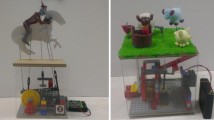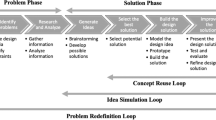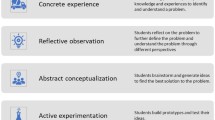Abstract
Engineering design practice has been recognized as an effective approach to engage students in STEM learning. However, we noticed that students who possessed strong STEM knowledge did not necessarily perform well on their design projects. Thus, this study sought to explore factors that shaped students’ design objectives and means. A design-based research was adopted using a single group teaching experiment, in which students’ performance in relation to conceptual knowledge, engineering design practice, and their STEM attitudes were assessed in different design complexity groups. Based on the findings of this study, we concluded that students’ interest and metacognitive skills might be the key factors affecting their motivation during the engineering design process. Their abilities in predictive analysis and testing/revising were core elements affecting their design thinking. Our work provides preliminary evidence on how students form and present different design purposes and objectives in an engineering design project.







Similar content being viewed by others
References
Asunda, P. A., & Hill, R. B. (2007). Critical features of engineering design in technology education. Journal of Industrial Teacher Education, 44(1), 25–48.
Atman, C. J., Adams, R. S., Cardella, M. E., Turns, J., Mosborg, S., & Saleem, J. (2007). Engineering design processes: A comparison of students and expert practitioners. Journal of Engineering Education, 96(4), 359–379. doi:10.1002/j.2168-9830.2007.tb00945.x.
Bannan-Ritland, B. (2003). The role of design in research: The integrative learning design framework. Educational Researcher, 32(1), 21–24.
Barrett, B. S., Moran, A. L., & Woods, J. E. (2014). Meteorology meets engineering: An interdisciplinary STEM module for middle and early secondary school students. International Journal of STEM Education, 1(1), 1–7. doi:10.1186/2196-7822-1-6.
Bennett, J., Braund, M., & Sharpe, R. M. (2013). Student attitudes, engagement and participation in STEM subjects. London: The Royal Society/Department of Education, The University of York.
Bernhard, J., Carstensen, A. K., & Holmberg, M. (2007). Design-based educational research and development of engineering education: Examples from courses in mechanics and electrical engineering. Paper presented at the 6th ASEE Global Colloquium on Engineering Education, Istanbul.
Blumenfeld, P., Soloway, E., Marx, R., Krajcik, J., Guzdial, M., & Palincsar, A. (1991). Motivating project-based learning: Sustaining the doing, supporting the learning. Educational Psychologist, 26(3 & 4), 369–398.
Brown, A. L. (1992). Design experiments: Theoretical and methodological challenges in creating complex interventions in classroom settings. The Journal of the Learning Sciences, 2(2), 141–178.
Burghardt, M. D., & Hacker, M. (2004). Informed design: A contemporary approach to design pedagogy as the core process in technology. The Technology Teacher, 64(1), 6–8.
Bybee, R. W. (2013). The case for STEM education: Challenges and opportunities. Arlington, VA: NSTA Press.
Carr, R. L., Bennett, L. D., IV, & Strobel, J. (2012). Engineering in the K-12 STEM standards of the 50 U.S. states: An analysis of presence and extent. Journal of Engineering Education, 101(3), 539–564.
Carr, R. L., & Strobel, J. (2012). Work in progress: Development of a metacognition scaffold in STEM/P-6 engineering context: MCinEDP. Paper presented at the Frontiers in Education Conference (FIE), OK.
Cobb, P., Confrey, J., diSessa, A., Lehrer, R., & Schauble, L. (2003). Design experiments in educational research. Educational Researcher, 32(1), 9–13.
Crismond, D. P., & Adams, R. S. (2012). The informed design teaching and learning matrix. Journal of Engineering Education, 101(4), 738–797.
Design-Based Research Collective [DBRC]. (2003). Design-based research: An emerging paradigm for educational inquiry. Educational Researcher, 32(1), 5–8.
Dewey, J. (1938). Experience and education. New York, NY: Kappa Delta Pi.
Dym, C. L., Agogino, A. M., Eris, O., Frey, D. D., & Leifer, L. J. (2005). Engineering design thinking, teaching, and learning. Journal of Engineering Education, 94(1), 103–120. doi:10.1002/j.2168-9830.2005.tb00832.x.
English, L. D., & King, D. T. (2015). STEM learning through engineering design: Fourth-grade students’ investigations in aerospace. International Journal of STEM Education, 2(1), 1–18. doi:10.1186/s40594-015-0027-7.
Erickson, F. (1986). Qualitative methods in research on teaching. In M. C. Wittroc (Ed.), Handbook of research on teaching. New York: Macmillan Press.
Fan, S. C., & Yu, K. C. (2016). Core value and implementation of the science, technology, engineering, and mathematics curriculum in technology education. Journal of Research in Education Sciences, 61(2), 153–183. doi:10.6209/JORIES.2016.61(2).06.
Fan, S. C., & Yu, K. C. (2017). How an integrative STEM curriculum can benefit students in engineering design practices. International Journal of Technology and Design Education, 27(1), 107–129. doi:10.1007/s10798-015-9328-x.
Grimm, S. L. (2010). Gateway to technology (GTT) Project lead the way (PLTW). Retrieved from http://www.lcsd.k12.ny.us/cms/lib/NY01001015/Centricity/Domain/4/PLTW-Board_Presentation_Nov_2010.pdf.
Guzey, S. S., Harwell, M., & Moore, T. (2014). Development of an instrument to assess attitudes toward science, technology, engineering, and mathematics (STEM). School Science and Mathematics, 114(6), 271–279. doi:10.1111/ssm.12077.
Hernandez, P. R., Bodin, R., Elliott, J. W., Ibrahim, B., Rambo-Hernandez, K. E., Chen, T. W., et al. (2014). Connecting the STEM dots: Measuring the effect of an integrated engineering design intervention. International Journal of Technology and Design Education, 24(1), 107–120.
Householder, D. L., & Hailey, C. E. (Eds.). (2012). Incorporating engineering design challenges into STEM courses. Retrieved from http://ncete.org/flash/pdfs/NCETECaucusReport.pdf.
International Technology and Engineering Educators Association [ITEEA]. (Ed.). (2009). The overlooked STEM imperatives: Technology and engineering. Reston, VA: Author.
Kelley, T., Brenner, D. C., & Pieper, J. T. (2010). PLTW and Epics-High: Curriculum comparisons to support problem solving in the context of engineering design. Utah, UT: National Center for Engineering and Technology Education (NCETE).
Khanlari, A. (2013). Effects of educational robots on learning STEM and on students’ attitude toward STEM. Paper presented at the 2013 IEEE 5th conference on engineering education (ICEED), Kuala Lumpur.
Kolmos, A., de Graaff, E., & Du, X. (2009). Chapter 2: Diversity of PBL-PBL learning principles and models. In X. Du, E. de Graaff, & A. Kolmos (Eds.), Research on PBL practice in engineering education (pp. 9–21). Boston: Sense Publishers.
Lantz, H. B., Jr. (2009). Science, technology, engineering, and mathematics (STEM) education what form? What function? Retrieved from http://www.currtechintegrations.com/pdf/STEMEducationArticle.pdf.
Lewis, T. (2005). Coming to terms with engineering design as content. Journal of Technology Education, 16(2), 37–54.
Lo, M. L., Marton, F., Pang, M. F., & Pong, W. Y. (2004). Toward a pedagogy of learning. In F. Marton & A. B. M. Tsui (Eds.), Classroom discourse and the space of learning (pp. 189–225). NJ: Lawrence Erlbaum.
Mahoney, M. (2010). Students’ attitudes toward STEM: Development of an instrument for high school STEM-based programs. Journal of Technology Studies, 36(1), 24–34.
McCormick, R. (2004). Issues of learning and knowledge in technology education. International Journal of Technology and Design Education, 14(1), 21–44.
McKenney, S., Nieveen, N., & Van den Akker, J. (2006). Design research from a curriculum perspective. In J. Van den Akker, K. Gravemeijeijer, S. McKenney, & N. Nieveen (Eds.), Educational design research (pp. 110–143). London: Routledge.
Mentzer, N. (2011). High school engineering and technology education integration through design challenges. Journal of STEM Teacher Education, 48(2), 103–136.
Mentzer, N., Becker, K., & Sutton, M. (2015). Engineering design thinking: High school students’ performance and knowledge. Journal of Engineering Education, 104(4), 417–432.
Merrill, C., Custer, R. L., Daugherty, J., Westrick, M., & Zeng, Y. (2009). Delivering core engineering concepts to secondary level students. Journal of Technology Education, 20(1), 48–64.
Mills, J. E., & Treagust, D. F. (2003). Engineering education—Is problem based or project-based learning the answer? Australasian Journal of Engineering Education, 3, 2–16.
National Research Council [NRC]. (2009). Engineering in K-12 education: Understanding the status and improving the prospects. Washington, DC: The National Academies Press.
NGSS Lead States. (2013). Next generation science standards: For states, by states. Washington, DC: National Academies Press.
Reeves, T. (2006). Design research from a technology perspective. In J. Van den Akker, K. Gravemeijeijer, S. McKenney, & N. Nieveen (Eds.), Educational design research (pp. 86–109). London: Routledge.
Sahin, A. (2015). A practice-based model of STEM teaching STEM students on the stage (SOS). Rotterdam: Sense Publishers.
Sanders, M. (2009). STEM, STEM education. STEMmania. The Technology Teacher, 68(4), 20–26.
Schnittka, C. G., & Bell, R. L. (2011). Engineering design and conceptual change in science: Addressing thermal energy and heat transfer in eighth grade. International Journal of Science Education, 33, 1861–1887.
Strauss, A., & Corbin, J. M. (1998). Basics of qualitative research: Techniques and procedures for developing grounded theory. Thousand Oaks, CA: Sage.
Taraban, R., Anderson, E. E., DeFinis, A., Brown, A. G., Weigold, A., & Sharma, M. (2007). First steps in understanding engineering students’ growth of conceptual and procedural knowledge in an interactive learning context. Journal of Engineering Education, 96(1), 57–68.
Thomas, J. W. (2000). A review of research on project-based learning. San Rafael, CA: Autodesk Foundation.
Wendell, K. B., & Rogers, C. (2013). Engineering-design-based science, science content performance, and science attitudes in elementary school. Journal of Engineering Education, 102(4), 513–540.
Acknowledgements
Funding was provided by Mistery of Science and Technology of Taiwan (Grant No. MOST 103-2511-S-003-007-MY3).
Author information
Authors and Affiliations
Corresponding author
Rights and permissions
About this article
Cite this article
Fan, SC., Yu, KC. & Lou, SJ. Why do students present different design objectives in engineering design projects?. Int J Technol Des Educ 28, 1039–1060 (2018). https://doi.org/10.1007/s10798-017-9420-5
Accepted:
Published:
Issue Date:
DOI: https://doi.org/10.1007/s10798-017-9420-5




